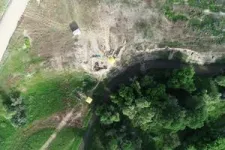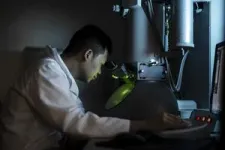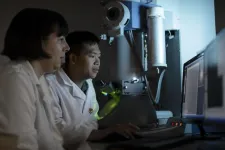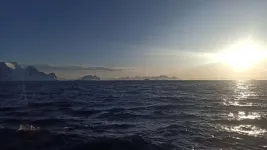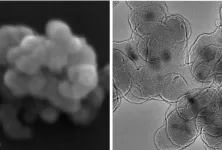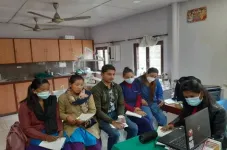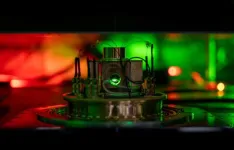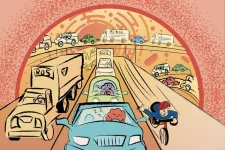(Press-News.org) A Wyoming archaeological site where people killed or scavenged a Columbian mammoth nearly 13,000 years ago has produced yet another discovery that sheds light on the life of these early inhabitants of North America.
Wyoming State Archaeologist Spencer Pelton and colleagues at the University of Wyoming and other institutions have found that these Paleolithic humans made needles from the bones of fur-bearers -- including foxes; hares or rabbits; and cats such as bobcats, mountain lions, lynx and possibly even the now-extinct American cheetah. The needles likely were used to create garments from the animals’ furs to keep the early foragers warm in what was a cool climate.
The findings appear in the journal PLOS ONE, a top-tier, peer-reviewed, open-access scientific journal published by the Public Library of Science.
“Our study is the first to identify the species and likely elements from which Paleoindians produced eyed bone needles,” the researchers wrote. “Our results are strong evidence for tailored garment production using bone needles and fur-bearing animal pelts. These garments partially enabled modern human dispersal to northern latitudes and eventually enabled colonization of the Americas.”
The LaPrele site in Converse County preserves the remains of a killed or scavenged sub-adult mammoth and an associated camp occupied during the time the animal was butchered almost 13,000 years ago. Also discovered in the archaeological excavation -- led by UW Department of Anthropology Professor Todd Surovell -- was a bead made from a hare bone, the oldest known bead in the Americas.
Identification of the origins of both the bone bead and bone needles was made possible through the use of zooarchaeology by mass spectrometry, also known as ZooMS, and Micro-CT scanning. Collagen was extracted from the artifacts, and the chemical composition of the bone was analyzed.
The researchers examined 32 bone needle fragments collected at the LaPrele Mammoth site, comparing peptides -- short chains of amino acids -- from those artifacts with those of animals known to have existed during the Early Paleondian period, which refers to a prehistoric era in North America between 13,500 and 12,000 years ago.
The comparison concluded that bones from red foxes; bobcats, mountain lions, lynx or the American cheetah; and hares or rabbits were used to make needles at the LaPrele site. This is the first such analysis ever conducted.
“Despite the importance of bone needles to explaining global modern human dispersal, archaeologists have never identified the materials used to produce them, thus limiting understanding of this important cultural innovation,” the researchers wrote.
Previous research has shown that, in order to cope with cold temperatures in northern latitudes, humans likely created tailored garments with closely stitched seams, providing a barrier against the elements. While there’s little direct evidence of such garments, there is indirect evidence in the form of bone needles and the bones of fur-bearers whose pelts were used in the garments.
“Once equipped with such garments, modern humans had the capacity to expand their range to places from which they were previously excluded due to the threat of hypothermia or death from exposure,” Pelton and his colleagues wrote.
How did the people at the LaPrele site obtain the fur-bearing animals? Pelton and his colleagues say it was likely through trapping -- and not necessarily in pursuit of food.
“Our results are a good reminder that foragers use animal products for a wide range of purposes other than subsistence, and that the mere presence of animal bones in an archaeological site need not be indicative of diet,” the researchers concluded. “Combined with a review of comparable evidence from other North American Paleoindian sites, our results suggest that North American Early Paleoindians had direct access to fur-bearing predators, likely from trapping, and represent some of the most detailed evidence yet discovered for Paleoindian garments.”
END
Wyoming research shows early North Americans made needles from fur-bearers
2024-11-27
ELSE PRESS RELEASES FROM THIS DATE:
Preclinical tests show mRNA-based treatments effective for blinding condition
2024-11-27
A new preclinical study by Mass Eye and Ear investigators showed that a novel mRNA-based therapy may be able to prevent blindness and scarring from proliferative vitreoretinopathy (PVR) following a retinal detachment repair or traumatic injury to the eye. There is no current treatment for PVR other than surgery, which itself carries a high risk of causing or exacerbating PVR. Their results, published in Science Translational Medicine, show the promise that mRNA-based therapies may one day offer patients with PVR and other retinal conditions.
“This ...
Velcro DNA helps build nanorobotic Meccano
2024-11-27
Researchers at the University of Sydney Nano Institute have made a significant advance in the field of molecular robotics by developing custom-designed and programmable nanostructures using DNA origami.
This innovative approach has potential across a range of applications, from targeted drug delivery systems to responsive materials and energy-efficient optical signal processing. The method uses ‘DNA origami’, so-called as it uses the natural folding power of DNA, the building blocks of human life, to create new and useful biological structures.
As a proof-of-concept, the researchers made more than 50 nanoscale objects, including a ‘nano-dinosaur’, ...
Oceans emit sulfur and cool the climate more than previously thought
2024-11-27
Researchers have quantified for the first time the global emissions of a sulfur gas produced by marine life, revealing it cools the climate more than previously thought, especially over the Southern Ocean.
The study, published in the journal Science Advances, shows that the oceans not only capture and redistribute the sun's heat, but produce gases that make particles with immediate climatic effects, for example through the brightening of clouds that reflect this heat.
It broadens the climatic impact of marine sulfur because it adds a new compound, methanethiol, that had previously gone unnoticed. Researchers only detected the gas recently, because ...
Nanorobot hand made of DNA grabs viruses for diagnostics and blocks cell entry
2024-11-27
CHAMPAIGN, Ill. — A tiny, four-fingered “hand” folded from a single piece of DNA can pick up the virus that causes COVID-19 for highly sensitive rapid detection and can even block viral particles from entering cells to infect them, University of Illinois Urbana-Champaign researchers report. Dubbed the NanoGripper, the nanorobotic hand also could be programmed to interact with other viruses or to recognize cell surface markers for targeted drug delivery, such as for cancer treatment.
Led by Xing Wang, a professor of bioengineering and of chemistry at the ...
Rare, mysterious brain malformations in children linked to protein misfolding, study finds
2024-11-27
In 1992, Judith Frydman, PhD, discovered a molecular complex with an essential purpose in all of our cells: folding proteins correctly.
The complex, a type of “protein chaperone” known as TRiC, helps fold thousands of human proteins: It was later found that about 10% of all our proteins pass through its barrel structure.
All animals have several different kinds of protein chaperones, each with its own job of helping fold proteins in the cell. TRiC binds to newborn proteins and shapes these strings of amino acids into the correct 3D structures, ...
Newly designed nanomaterial shows promise as antimicrobial agent
2024-11-27
HOUSTON – (Nov. 27, 2024) – Newly developed halide perovskite nanocrystals (HPNCs) show potential as antimicrobial agents that are stable, effective and easy to produce. After almost three years, Rice University scientist Yifan Zhu and colleagues have developed a new HPNC that is effective at killing bacteria in a biofluid under visible light without experiencing light- and moisture-driven degradation common in HPNCs.
A new method using two layers of silicon dioxide that Zhu and colleagues developed over years of work was used in experiments with lead-based and bismuth-based HPNCs to test their antimicrobial efficacy and stability in water. ...
Scientists glue two proteins together, driving cancer cells to self-destruct
2024-11-27
Our bodies divest themselves of 60 billion cells every day through a natural process of cell culling and turnover called apoptosis.
These cells — mainly blood and gut cells — are all replaced with new ones, but the way our bodies rid themselves of material could have profound implications for cancer therapies in a new approach developed by Stanford Medicine researchers.
They aim to use this natural method of cell death to trick cancer cells into disposing of themselves. Their method accomplishes this by artificially bringing together two proteins in such a way that the new compound switches on a set of cell death genes, ultimately driving tumor cells to turn on themselves. ...
Intervention improves the healthcare response to domestic violence in low- and middle-income countries
2024-11-27
Culturally appropriate women-centred interventions can help healthcare systems respond to domestic violence, research has found. HERA (Healthcare Responding to Violence and Abuse) has been co-developing and evaluating a domestic violence and abuse healthcare intervention in low- and middle-income countries for the past five years. This National Institute for Health and Care Research (NIHR) Global Research Group will report their findings, and publish a PolicyBristol report, at a conference in London today ...
State-wide center for quantum science: Karlsruhe Institute of Technology joins IQST as a new partner
2024-11-27
The mission of IQST is to further our understanding of nature and develop innovative technologies based on quantum science by leveraging synergies between the natural sciences, engineering, and life sciences. "Many KIT scientists already successfully support IQST with their expertise as Fellows. All the more I am pleased that the Karlsruhe Institute of Technology is now joining our interdisciplinary centre as an institution," says IQST Director Prof. Stefanie Barz. "This will strengthen networking within the academic quantum community in Baden-Württemberg," emphasizes ...
Cellular traffic congestion in chronic diseases suggests new therapeutic targets
2024-11-27
***Embargoed until November 27 at 11 AM EST***
Chronic diseases like type 2 diabetes and inflammatory disorders have a huge impact on humanity. They are a leading cause of disease burden and deaths around the globe, are physically and economically taxing, and the number of people with such diseases is growing.
Treating chronic disease has proven difficult because there is not one simple cause, like a single gene mutation, that a treatment could target. At least, that’s how it has appeared to scientists. However, research from Whitehead Institute Member Richard Young and colleagues, published in the journal ...

